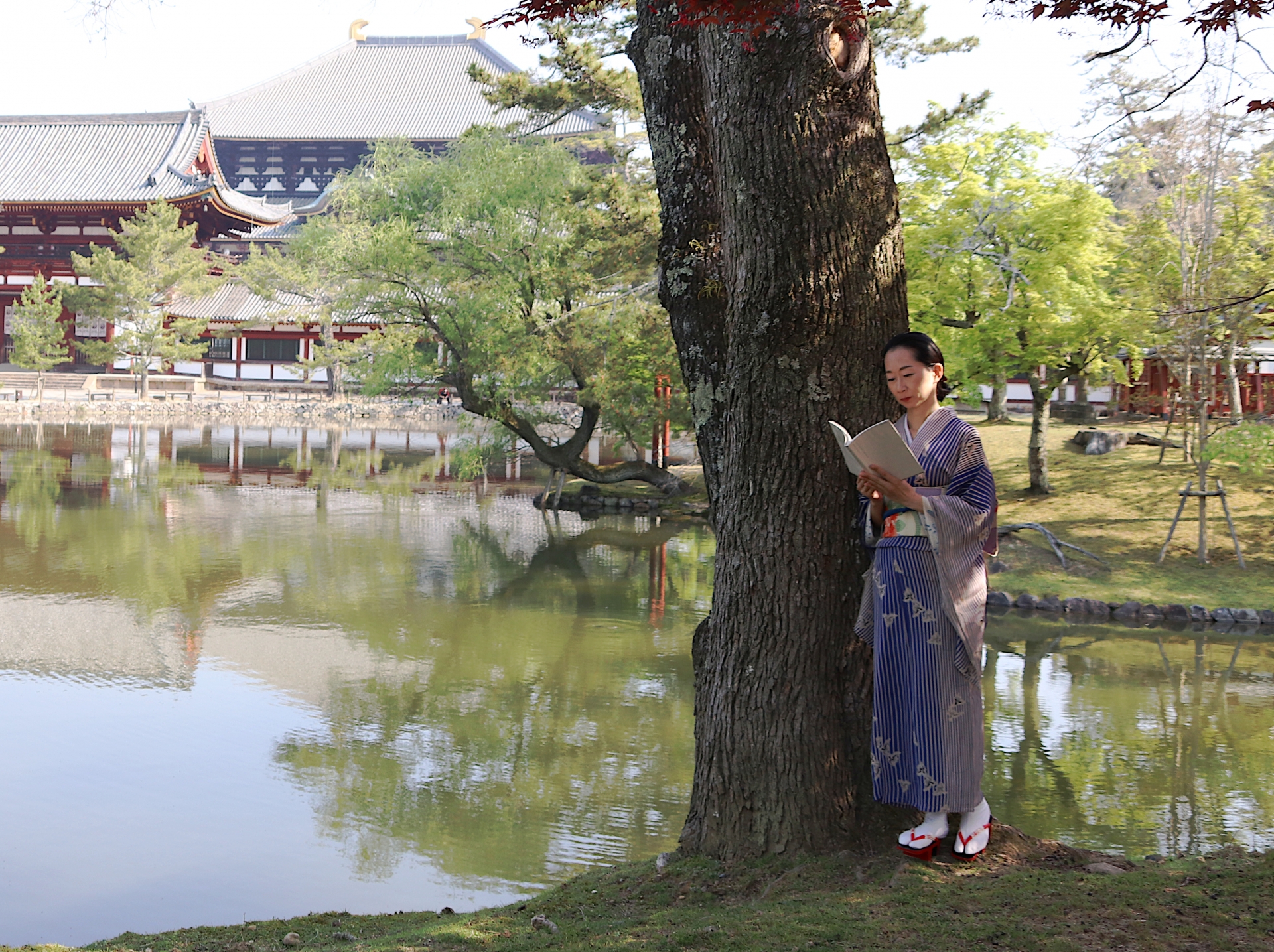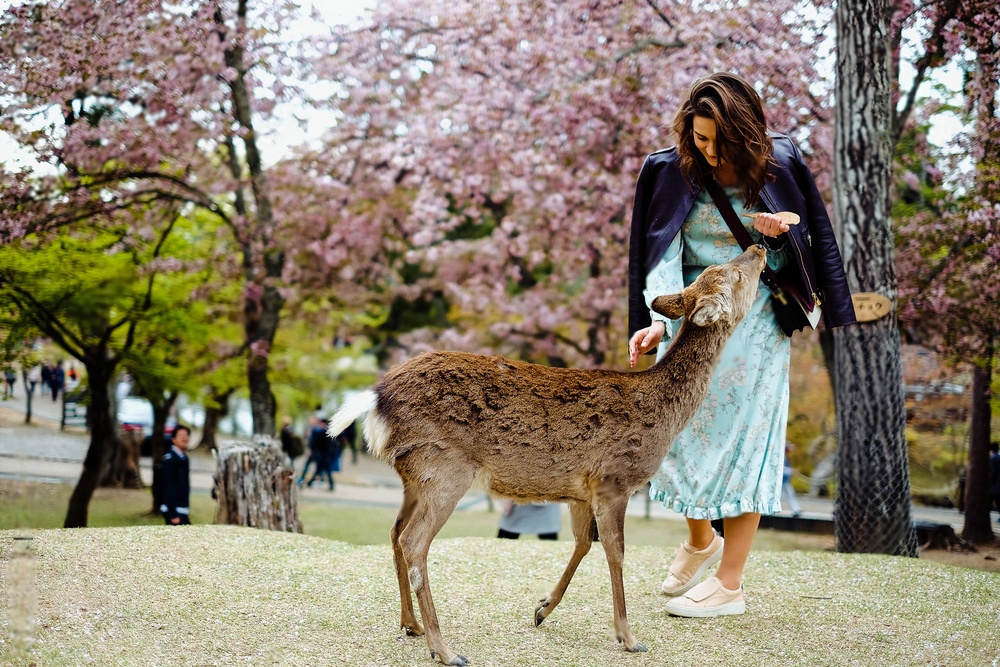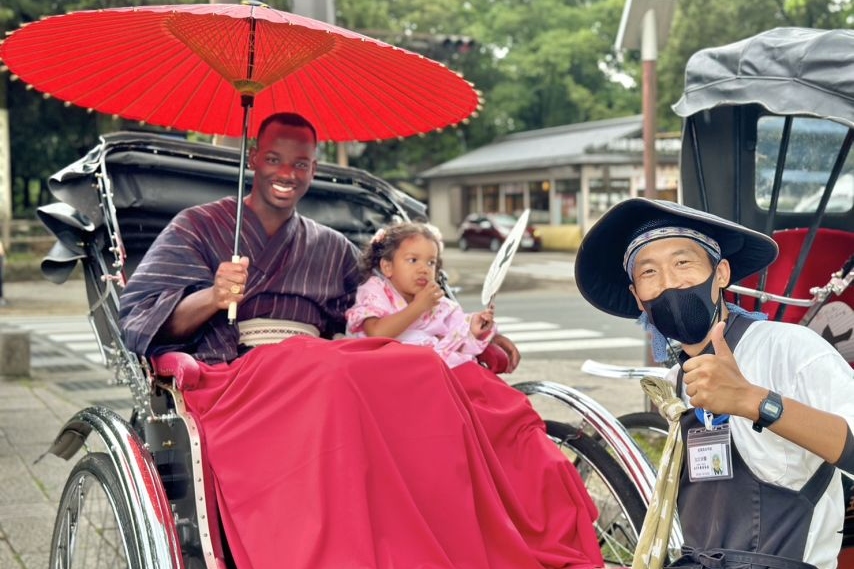
[Guaranteed Departure for 1 : Japan Kyoto Nara One Day Tour: Kiyomizu Temple, Hanami Koji, Fushimi Toka Shrine & Nara Park | Japan
- Local professional "old driver", reliable and considerate service, detailed understanding of the local customs and practices in Japan
- Classes depart every day, and only one person is needed
- Optional hotel pick-up in downtown Osaka, no need to worry about route planning and complicated public transportation
- Travel the best of Kansai in one day, visit Kiyomizu Temple and rub shoulders with geishas in Gion
Options
Kyoto Nara Day Tour
Inclusions
Service charge
Transportation fare
Toll fee
Parking fee
Driver
Exclusions
Entrance fee
Attraction tickets
Dining expenses
Personal expenses
Other expenses not mentioned above
Additional Info
Children aged 0 to 2 can participate for free. Please note this when making a reservation.
What's included in [Guaranteed Departure for 1 : Japan Kyoto Nara One Day Tour: Kiyomizu Temple, Hanami Koji, Fushimi Toka Shrine & Nara Park | Japan
(Subject to Option Inclusions)Itinerary
Hotels/B&Bs within the Osaka Loop Line *The order and time of pick-up will be arranged by the driver based on the distance of the journey. Please understand and cooperate with each other and follow the driver's arrangement.

Nipponbashi Exit 2 Namba-Shinsaibashi Area (Meet and greet package)

Kyoto Station Hachijo Exit - Station Front Sightseeing Bus Parking Lot (Meet and Go Package)

Kiyomizu Temple area (about 2.5 hours, including time for lunch and free time)

Fushimi Inari Taisha Shrine (about 70 minutes, free time)

Nara Park (about 1.5 hours, free time)

The day's tour ended happily and we started to return (the group did not stop in Kyoto on the return trip, but only disbanded in Osaka)
Shinsaibashi and Dotonbori areas (approximately 1 hour, passengers boarding the bus at the designated meeting point will be dismissed immediately)

The above itinerary is for reference only. The attractions, tour sequence and time may be changed according to the situation on the day.
![Additional recommendation: [Kiyomizu Temple] World Cultural Heritage, a popular tourist attraction in Kyoto. Founded in 778, it is the oldest temple in Kyoto and a national treasure of Japan. Jishu Shrine is located on the north side of the main hall of Kiyomizu Temple. It is a shrine for making friends and praying for love in Japan.](https://image.kkday.com/v2/image/get/w_960,c_fit,q_55,wm_auto/s1.kkday.com/product_135949/20240625101306_AqNFE/jpg)

![Additional recommendation: [Ishibe Alley] Turn right at the end of Ninenzaka and continue walking north, you will see Ishibe Alley, where there are fewer tourists. Elegant traditional Japanese houses are located on both sides of the cobblestone path, making people feel like they are going back in time, away from the hustle and bustle, and returning to tranquility.](https://image.kkday.com/v2/image/get/w_960,c_fit,q_55,wm_auto/s1.kkday.com/product_135949/20240625101323_L7Oao/jpg)
![Additional recommendation: [Ninen-zaka and Sannenzaka] Located outside Kiyomizu Temple, Ninen-zaka and Sannenzaka are slopes with unique Kyoto style and are listed as Japan's "Important Traditional Buildings Protection Area". On both sides of the stone slope are Japanese-style buildings full of ancient charm, with a strong Japanese style, and a variety of delicacies, paper fans, dolls, chopsticks and other handicrafts that are dazzling.](https://image.kkday.com/v2/image/get/w_960,c_fit,q_55,wm_auto/s1.kkday.com/product_135949/20221117072745_6MeJ8/jpg)
![Additional recommendation: [Todaiji Temple], also known as the Great Kegon Temple, was built in 752 by Emperor Shomu to worship the Great Buddha and serve as the head temple of Japanese temples. It is the main temple of Kegon sect. Two fires destroyed the building. The current one was rebuilt in 1692 and is two-thirds of the original building. The main Buddha Hall of Todaiji Temple is 57 meters wide and 50 meters deep, making it the largest wooden building in the world. In the Great Buddha Hall, there is a large Buddha statue over 15 meters high, 99 Rushana Buddha. There are also Nandaemun, Nigatsudo, Sangatsudo, etc. in Todaiji Temple.](https://image.kkday.com/v2/image/get/w_960,c_fit,q_55,wm_auto/s1.kkday.com/product_135949/20240625101304_olUCH/jpg)
The content of this product is provided by machine translation and may not reflect the actual information, please take this into consideration before booking.
- Kiyomizu Temple Area
Recommended itinerary
Recommendation 1: Kiyomizu Temple (ticket fee is at your own expense) - Ninzanzaka, Sannenzaka - Ishibe-koji - Gion, Hanami-koji - Yasaka Shrine
Guests can choose to visit some attractions according to their preferences and physical condition.
Recommendation 2: Kimono experience. Interested guests can put on a kimono, stroll along the ancient streets, visit Kiyomizu Temple, and capture the most beautiful moment.
(You can choose to return kimonos at any of the many kimono shops including Kiyomizu Temple and Fushimi Inari Shrine. We recommend that you borrow from Kiyomizu Temple and return them at Fushimi Inari. Please pay for the expenses yourself.)
Additional recommended attractions:
【Gion·Hana-koji】An ancient and famous flower street. In the 1960s, there were nearly a thousand geishas in Kyoto. Today, there are still dozens of geisha teachers who provide training in traditional tea ceremony, flower arrangement, koto, gagaku, kyogen, maiko, bunraku, etc. Walking into the flower street, an ancient atmosphere hits you: tea houses with exquisite facades on both sides, wooden lattice windows and doors are tightly closed... This is a mysterious path running from north to south, with a total length of about 1 kilometer. The northern section is modern, the southern section is traditional, and the north and south have their own styles and are leading the trend.
(You can enjoy Kyoto-style lunch, admire the ancient Japanese-style buildings, and take photos with your mobile phone camera)
- Fushimi Inari Taisha Shrine
Fushimi Inari Taisha is famous for its "Thousand Torii Gates". It attracts countless tourists from Japan and abroad every year. It has been ranked first in the "Most Popular Japanese Attraction for Foreigners" in a survey conducted by the world's largest travel website for three consecutive years. Let's pray for ourselves and our beloved family here. In addition, the painted horse of Fushimi Inari Taisha is also unique. It is in the shape of a white fox, and you can use your imagination to doodle various expressions.
- Nara Park
Nara Park is an urban park located at the foot of Mount Wakakusa in Nara City. Todaiji Temple, Kasuga Taisha Shrine and other Nara attractions are all here. It is a must-see for tourists in Nara. Mount Wakakusa, located near the park, is a wonderful place to overlook the scenery of Nara. Traditional activities such as "Wakakusa Burning the Mountain" are held here every January. A leisurely stroll is the best way to visit the park. There is also the most concentrated herd of deer here. Feeding the cute little deer is also the biggest attraction for tourists. The deer here are also very spiritual. They will come to you when they see tourists with deer biscuits in their hands, so you need to be careful of groups of deer coming to pounce on you.
- Shinsaibashi and Dotonbori areas
Guests can choose to spend about 1 hour in the Shinsaibashi area of Osaka. After the tour, guests who have the boarding package can disband directly in the Shinsaibashi area to end the trip. Guests who have the hotel/homestay drop-off/pick-up package should wait for the shuttle bus to arrive and then be sent back to the hotel/homestay to end the trip.
Shinsaibashi: Osaka's most famous shopping street, it is home to large department stores, chain drugstores, old brand stores and small shops. There are all kinds of goods of all grades and styles, and Hello Kitty and Disney stores are also located here. It is also a gathering place for drugstores that girls like, and you can buy cosmetics and skin care products at will. Most stores are equipped with Chinese shopping guides and accept UnionPay card payments, so you can easily enjoy the fun of shopping.
Dotonbori: a synonym for Osaka's food, a street that never rests, whether it's day or night. As the birthplace of Osaka's so-called "eat until you drop" food culture, Dotonbori has many delicious snacks such as octopus balls, okonomiyaki, and Jinlong ramen, as well as traditional Japanese izakayas and various Internet celebrity restaurants, such as the popular Kani Doraku.
Inclusions
- In the event of inclement weather such as typhoons or snowstorms, a decision on whether to cancel the tour will be made 1 day(s) before departure (local time 18:00). Notifications will then be sent via email
- High blood pressure, Heart disease, Acrophobia, Asthma, Epilepsy, Pregnant women
- Travelers with the following conditions or other health issues that could be worsened by excessive stimulation should not participate in this activity
- Please arrive at the designated location 10 minute(s) before the scheduled departure time, as the tour will depart on time
- After the order is confirmed, the date cannot be changed at will. If any loss is caused, you will be responsible for it yourself.
- Please note that no refund will be given if you fail to participate or cancel the trip due to personal issues, lateness, etc.
- When making a reservation, be sure to provide complete information (name + number of people + phone number + WeChat ID + pick-up location) to avoid errors that may affect your trip.
- The arrival time of each itinerary may change due to traffic conditions, weather, festivals, and crowds on the day. Please forgive us if the itinerary is delayed or cancelled due to the above or other force majeure factors. We cannot request a refund on this basis.
- Elderly people, people with high blood pressure, heart disease or other cardiovascular diseases, pregnant women, etc. are recommended to be accompanied by relatives. This tour does not accept individual registrations by customers under the age of 18. If you wish to register, please ask your guardian to register for this tour together.
- Please wear light, travel-friendly clothing and shoes for this tour.
- Please be sure to abide by local laws and regulations in Japan and do not bring items prohibited by Japanese law to avoid violating the law and affecting your own rights.
- This is a fixed carpooling itinerary. Please be sure to abide by the stay time at each attraction and follow the arrangements of the driver and guide.
- During the trip, please carry your passport and valuables with you and keep them properly. If they are lost, stolen, or damaged, you will be responsible for the consequences.
- If you leave the group on your own during the trip, the transaction will be deemed invalid and no fees will be refunded. If personal or property safety is affected as a result, the consequences will be borne by you.
- The specific boarding time and the leader's license plate information will be sent to your email before 21:00 Japan time the day before departure. Please check your email at that time. If you do not receive the email, please contact us immediately.
- The return trip does not stop in Kyoto and the tour will only end in Osaka.
Meet
Venues
- Nipponbashi Exit 2 Namba Shinsaibashi AreaFrom08:40View on Map
- Kyoto Station Hachijo Exit Sightseeing Bus Stop In Front Of The StationFrom09:50View on Map
Meeting / End Points
- Nara Park
Policies
Purchase Summary
- Each person can bring one piece of luggage for free, regardless of size (please note when registering)
- Children aged 0-2 years old can be carried for free without occupying a seat; please inform us in advance; children aged 3 years old and above are charged the same as adults. Small groups picked up by the hotel are charged for children aged 0 and above.
- If you do not book the number of children under 3 years old who do not occupy a seat in advance, and the car is not full, you will be refused boarding and the fee will not be refunded
- Driver-guide service (1-13 people small group; 14-45 people bus group, actual number will be adjusted according to the number of people on the day)
- Reference vehicle types: 5-8 seater: Toyota Alphard; 9-14 seater: Toyota HAICE or equivalent; 18-22 seater: minibus; 22 seater and above: large bus. The above vehicles are for reference only and will be adjusted according to the number of people on the day.
【Travel conditions】
- Travel origin and destination: Osaka and Kyoto
- Travel days: Round trip
- Transportation: Chartered bus
- Bus company name: Reisei Tourism Industry Co., Ltd.
- Meals: Breakfast 0 times Lunch 0 times Dinner 0 times
- Accommodation facilities: None
- Minimum number of people in a group: 1
- Team leader: 1
【Travel planning/implementation】
- Name of operating company: TuYi Group Japan Co., Ltd.
- Address: 722 Shuzenji, Izu City, Shizuoka Prefecture
- License Number: Shizuoka Prefectural Governor Registered Travel Agency, No. 2-633
- Travel Agency Association: Regular Member of the Japan Association of Travel Agents (JATA)





